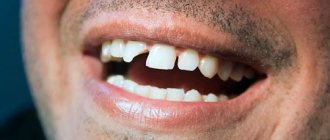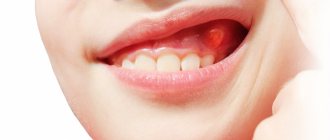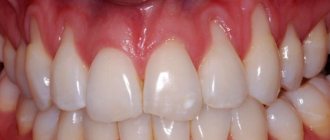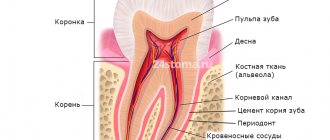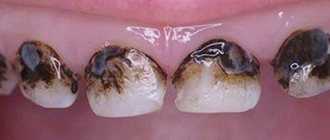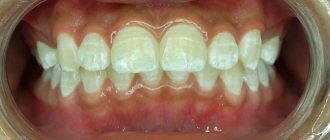Before getting rid of cracks in the enamel in teeth, the doctor prescribing treatment must carefully examine the damaged units, conduct other diagnostic tests and find out the exact cause of the problem. There are many factors that can cause scratches and breaks. The patient should not ignore such symptoms, since over time they can develop into a serious pathological process requiring long-term therapy and rehabilitation. Refusal to visit a doctor often leads to the loss of incisors, canines and molars. Compliance with preventive recommendations significantly reduces risks.
What is a tooth crack
This is a split in the enamel that can be quite deep or affect only the superficial layers. In this case, the unit does not have contrasting pigmentation, is not broken or loosened.
Cracked crowns cause pain. If the defect is small, only an experienced dentist can notice it during an examination. Larger damage is visible to the naked eye. They are especially visible after drinking coloring drinks (coffee, tea, soda).
Even when the crack is extremely small, mandatory medical intervention is required. A slight stripe on hard tissue increases over time, becomes deeper and leads to the loss of not only the crown part, but also the roots.
Prevention
To prevent dental injuries, you must:
- Observe safety precautions at work, arrange the workplace and carry out potentially hazardous work in accordance with established rules.
- Properly equip playrooms for children and supervise children while playing.
- Follow traffic rules and use seat belts when traveling, as even minor emergency braking of the car carries a high risk of injury.
- Avoid conflict situations that lead to fights.
- Ensure the safety of sports games using special equipment (helmets, masks, dental guards).
- Carefully select sports grounds: they must comply with safety requirements.
Reasons why cracks appear in tooth enamel
There are several factors:
- Mechanical impact. The person may be hit or otherwise injured. This can also happen if you chew nuts or eat other solid foods.
- Deficiency of vitamins and minerals. When the body lacks fluoride, calcium and other essential substances, the upper layer of incisors, canines and molars becomes thinner and becomes susceptible to irritants.
- Temperature changes. This happens when you eat hot and cold at the same time.
- Bruxism. Pathology leads to deterioration of bone tissue, abrasion and destruction.
- Using pastes with abrasives. With their regular use, the lateral and front teeth crack, as if cracks appear on them, as well as scratches intersecting with each other. Large particles lead to thinning of the enamel. The protective layer wears off and can no longer perform its functions.
- Dentist's mistake. With poor quality treatment and some cosmetic manipulations, the doctor may damage the surface with instruments.
- Foods in the diet containing a large amount of acids (for example, citrus fruits, berries) and chemical dyes (sweet soda). At first, a person notices a significant increase in sensitivity.
- Taking certain medications (antibacterial drugs, etc.).
- Installation and wearing of braces.
- Smoking and other bad habits (picking your mouth with nails, hard objects).
- Insufficient hygienic care of the oral cavity.
- Bite abnormalities.
Provoking factors
A crack is considered one of the most dangerous and painful injuries to the elements of the jaw row. It can form as a result of injury or other predisposing factors.
The main causes of damage include:
- household or sports injuries, which entail not only the formation of a crack, but also damage to the root system;
- biting hard objects (nuts, opening bottle caps, etc.);
- grinding of lateral incisors;
- poor-quality dental treatment, which entails a split of the root into two parts with a further crack in the enamel;
- lack of microelements (potassium and fluorine) in the body;
- congenital or acquired increased thinness of enamel;
- careless play (typical for pediatric patients);
- insufficient oral hygiene;
- alternating very hot or cold foods.
It is worth noting that a crack does not always make itself felt immediately after an injury. Very often it develops gradually, which is why it is considered dangerous.
Untimely treatment threatens the development of serious complications, including complete loss of the problem element.
Why are dental cracks dangerous?
If such a problem is discovered, the consequences can be very serious. For example, in some cases it is unavoidable to delete a unit. If treatment is not started in a timely manner, scratches under regular loads will turn into wide fractures, and the pathological process will affect deeper layers (dentin).
What is the danger:
- A damaged incisor, canine or molar is not protected from external influences. As a result, sensitivity progresses, especially if a person consumes cold, hot, sweet and sour foods. Pain is felt when biting food.
- Food particles, plaque, and pathogenic microorganisms accumulate in the cracks. This is a favorable environment for the appearance and growth of caries, periodontitis, and pulpitis.
- A frequent complication is the occurrence of chips. Because of this, injury occurs to the gums, tongue, and the inside of the cheeks. Injuries to the mucous membranes complicate symptoms and lead to deterioration of well-being.
- Loss of a unit. This is an irreversible consequence. If the crown is completely cracked and restoration is impossible, the dentist performs an extraction. Otherwise, the risk of pulp infection increases.
- The presence of psychological discomfort. A person feels unattractive due to unaesthetic small stripes on his teeth.
Content
- Causes of destruction
- Activities before treatment with a doctor
- Temporary filling fell out
- A permanent filling fell out
- Price
- Prevention of destruction
No one is safe from falling out or partial chipping of a filling. The patient experiences discomfort. This is both a moral component and very real inconvenience. The problem becomes the inability to chew food normally, excessive tooth sensitivity, even pain. You need to contact a specialist immediately to stop tooth decay and restore its normal functions.
PROMOTION
Dental restoration, installation of fillings
from 2200 rub.
Classification of cracks
There are several generally accepted types of such damage in dentistry. Each of them has its own characteristics and poses a certain health hazard. Late diagnosis and treatment significantly reduces the likelihood of saving the unit.
What are the types of cracks (microcracks) on teeth:
- Vertical. The crown and deep root region are affected. If the phenomenon has spread over the entire length of the incisor, canine or molar, no restorative measures will help. The doctor performs an extraction.
- Horizontal. In the absence of therapeutic intervention, chips form. The closer to the gum the scratch is, the higher the risk of chipping.
- Inclined. The defect runs diagonally. Ignoring symptoms leads to the development of pathogenic microflora and caries.
- Internal. Not easy to detect. Detected using an x-ray. Most often, patients go to the dental clinic after a fracture caused by such a crack in the teeth (we’ll look at how to remove it and how to treat it below).
- Root. The split goes through the root. If the damage is extensive, removal cannot be avoided.
- At the base. Since the dentinal layer suffers, among other things, inflammation is observed and pain is felt.
Cracks are also divided into deep, superficial and multiple. Not all of them are accompanied by unaesthetics, so it is important to pay attention to the accompanying manifestations.
Features of tooth trauma
A crack in the crown of a tooth can be small in size, and then it can only be identified during a routine examination or diagnosis. Significant damage is noticeable visually.
If a tooth is cracked, it can be saved, but it is important not to ignore the symptoms:
With hidden damage, symptoms may appear:
- non-localized toothache of a permanent nature;
- tooth sensitivity when eating.
If you go to the dentist in a timely manner, you can save a chipped tooth. However, if you ignore the symptoms, complications may arise:
- infection or inflammation of the pulp or gums;
- tissue necrosis;
- soft tissue tumor;
- bleeding gums;
- tooth root mobility;
- tooth displacement.
For the purpose of tooth reconstruction, patients turn to the dentist much more often for aesthetic reasons, when a defect spoils the smile. It should be understood that a crown crack is a pathology and requires not only its restoration, but also treatment of the consequences of the injury.
Additional symptoms
The problem is visible to the naked eye if it touches the front incisors. In other cases, most often the damaged surface is not noticeable. Therefore, patients often come to the clinic when the tissues are already severely damaged.
Auxiliary symptoms indicating a pathological process:
- pain of uncertain localization;
- increased sensitivity to hot and cold;
- discomfort when chewing food;
- unpleasant odor from the mouth;
- inflammation of the mucous membranes in the mouth;
- change in enamel shade;
- bleeding when pressing the unit.
Treatment
If a tooth crack is detected, treatment should be carried out as soon as possible to avoid further destruction and complications. After all, pathological processes occurring in the bone tissue of a cracked tooth can lead to the need for its complete removal.
In children, treatment of damaged milk teeth consists of grinding off the masticatory cusps in order to remove them from participation in the chewing process and reduce the load. Adults and children with molars may benefit from endodontics for a short time. It will remove pain symptoms, but the likelihood of maintaining the integrity of the crown is very low.
In case of minor damage, it is recommended to gradually remove microscopic layers of enamel, followed by polishing the defective area and coating it with fluoride varnish. For more serious damage, it is recommended to use metal-ceramic crowns, which allow you to keep the tooth alive for some time.
Diagnostic methods
When the first suspicious signs appear, you should visit the dentist. Dentists not only conduct a visual examination, but also use special instruments. To determine the location and extent of tissue damage, an x-ray examination is prescribed. What to do if a crack appears inside a tooth is decided based on the results of diagnostic procedures.
Numerous scratches can be detected without the use of tools. The deep ones can only be seen under the influence of light, while the surfaces are dried with cotton balls. Superficial flaws are detected using a magnifying glass or in a special way - transillumination.
Making an accurate diagnosis can be difficult. This is due to the frequent absence of characteristic symptoms. Specialists take into account all manifestations in their entirety: the patient’s sensations, his medical history, x-rays, exacerbation of symptoms during treatment.
All methods are combined, since this way the dentist will be able to objectively assess the situation and develop a therapeutic regimen. For this we use:
- instrumental examination of the oral cavity;
- examination under a microscope;
- transillumination;
- staining with contrast agents.
In some cases, exploratory surgery is indicated. This is the exfoliation of dentin particles and the removal of granulation tissue for subsequent painting of the damaged layer. In this way, even microcracks are visualized. Sometimes root resection is performed.
Cracked wisdom tooth
There are also cases of damage to wisdom teeth, since during prolonged eruption they are subject to increased destruction and constant exposure to pathogenic bacteria. A figure eight fissure is not a rare phenomenon, and if access to the damaged area is difficult, the doctor is unlikely to waste time on treatment. So if you are experiencing severe discomfort and pain due to a cracked wisdom tooth, the most rational solution would be to remove it. In any case, it does not bear any functional load and is located in that part of the jaw where its absence cannot be determined visually.
Treatment of horizontal and vertical cracks in tooth enamel
Therapeutic tactics are developed exclusively by a specialist based on the diagnostic results, size and localization of cracking. The most commonly used methods are:
- Remineralization. A special composition containing a large amount of calcium and fluorine is applied to the surface. As a result, the units become smooth, and increased sensitivity disappears.
- Restoration. The chipped fragment is removed and replaced with a composite overlay.
- Veneers. Suitable if the defects are shallow but numerous. Before use, it is necessary to treat caries and other pathologies.
- Crowns. Suitable for cracks along the entire length of the unit. Installed on cement or bridge.
- Depulpation. When the pulp is severely damaged, it is removed. In case of partial damage, dentists remove only the pathological elements of the nerves.
- Extraction. A radical method, it is indicated in cases where an incisor, canine or molar cannot be saved. During surgery, local anesthesia is used.
Why tooth extraction may be necessary
When a unit needs to be removed according to indications, you should not try to save it. The fact is that even with restoration, after some time you will have to remove the damaged element. However, further implantation and prosthetics may be difficult.
Getting rid of cracked parts is also carried out due to inflammation in the oral cavity. If you leave everything as is, it will negatively affect the condition of all elements.
What to do if your child’s enamel is cracked
Babies constantly put various objects into their mouths. This leads to injury to units. What do cracked teeth look like in preschool children (the causes and symptoms of the pathology are listed above)? Externally, the defect is no different from similar problems in adults, but does not cause such severe consequences.
Over time, the bite will change to permanent, so the situation should not be a cause for alarm, but it is necessary to visit a doctor in any case. Some types of damage affect the formation of root rows. And during the examination, hidden pathologies and injuries are often revealed.
If pain is present, you can give your child a mild pain reliever recommended by specialists. You also need to make sure that the baby does not put his hands in his mouth.
What to do if there is a crack in the tooth enamel of the front tooth
You can notice the problem yourself. But it is important to immediately contact your dentist to prescribe therapy. Restorative measures to strengthen the structure are preliminarily shown.
Typically, surfaces are treated with compounds containing valuable minerals. If necessary, voids are filled with polymers.
Procedure for the presence of microcracks in the front:
- cleaning the enamel layer;
- polishing and grinding;
- fluoride varnish treatment.
It is worth taking care in advance about the absence of oral diseases. Otherwise, the inside of the units may become infected, causing them to eventually crack.
What to do if a crack appears on a tooth - help at home
Attempts to independently restore the integrity of the scratched layer will not bring any results. If done incorrectly, it will affect neighboring units. Treatment should be carried out by a doctor.
At home, it is recommended to treat the surface with an antiseptic solution. This prevents the development of the inflammatory process. If there is pain and other unpleasant sensations, drugs with an anesthetic effect are indicated.
It is important to refrain from eating before seeing a specialist. When this is not possible, chew food on the healthy side. If the defect is deep, brushing should not be done until visiting a doctor.
Complications and consequences of a root crack
In this situation, timely treatment is important: seeing a doctor at the initial stage will help avoid consequences. If this is not done, you may encounter the following complications:
- abscess.
A crack without treatment can provoke an inflammatory process, which in the future will turn into suppuration of soft tissues and lead to the formation of an abscess. Treatment of a purulent cavity is much longer, more expensive and unpleasant than treatment of a fissure; - phlegmon.
Suppuration, which, unlike an abscess, does not have clear boundaries and does not flow into the formation of a cavity. Cellulitis is a decay of cells that can spread to any tissue in the cavity; - periodontitis.
Inflammation of the periodontium, that is, the tissues surrounding the tooth, leads to their death and the inability to hold the tooth in the gum. The result is the complete loss of one or more teeth; pulpitis. The death of the pulp - the neurovascular bundle of tissues in the tooth through which it receives nutrition. Pulpitis is quite painful and can affect neighboring tissues; - tissue injury.
A root fragment can injure soft tissue. In this case, the doctor will have to extract a piece of the root and remove the infected tissue.
Cracks when wearing braces or after removing them
Damage can appear even after the most harmless procedures. For example, this applies to bleaching. Long-term use of an orthodontic system also leads to deterioration of the enamel layer. For this reason, after a therapeutic course, restorative remineralizing therapy is indicated.
To prevent the design from causing scratches, you need to follow simple recommendations:
- regular hygienic oral care;
- using an irrigator for better cleansing;
- using a special bracket brush for cleaning;
- Enzyme rinses at home.
If the integrity of the seal is damaged, its replacement is indicated. If necessary, caries is treated. Inexperienced dentists sometimes recommend grinding the surface to get rid of discomfort, but this option is unacceptable.
If a defect appears on an artificial crown, the prosthesis is removed, and doctors examine the patient. Further therapeutic tactics depend on the location of the problem and the depth of the damage.
First aid
If unpleasant symptoms appear, it is best to immediately seek help from a dentist; timely treatment will reduce the risk of developing complications in the future.
If this is not possible, then it is important to provide first aid correctly. These activities include:
- rinse the mouth with antiseptic solutions (Chlorhexedine, Furacilin, etc.);
- for severe pain, you can take local analgesics (Nurofen, Ibuprofen, etc.);
- limit any contact of the cracked element with food or tongue, otherwise this may lead to chipping of the enamel;
- limit temperature changes.
It is worth noting that such measures will not help get rid of the problem, but will only relieve unpleasant symptoms. Self-medication can lead to the development of serious complications.
Recovery methods
The choice of treatment method depends on the type and depth of the damage. Only a doctor can determine the correct treatment regimen after a thorough examination of the patient.
It is important to understand that a crack does not always lead to a split tooth and requires serious treatment.
Enamel restoration
This includes procedures for remineralization and fluoridation of enamel. In the first case, I saturate the surface with fluorine, calcium and other necessary minerals and trace elements. This helps strengthen the enamel and prevent further cracking.
Fluoridation is carried out in several stages; this method is considered more durable than the previous one.
Sealing
This procedure is performed primarily on molars. Applying filling material helps solve the problem of small cracks, chips and discoloration of the enamel.
Before installing a filling, the root canal must be cleaned, etc. As a rule, the doctor eliminates shallow damage in one session.
Covering with veneers
The procedure involves placing a veneer, made primarily of ceramic, on the outer surface of the tooth.
They do not require periodic correction and have a good aesthetic appearance. The procedure is carried out in several stages; veneers are made to the patient according to individual sizes.
The disadvantage of this method is its high price. Among the advantages are long service life and beautiful appearance (people around will not distinguish a veneer from an anatomical organ).
Building up
To restore the fragment, a special composite resin is applied. The color can be selected individually, thus ensuring an attractive appearance.
The advantage of this method is its low cost and the absence of the need for frequent visits to the dentist. The disadvantage is the fragility of such material.
The duration of the entire procedure does not take more than 30 minutes, during which the patient does not feel any discomfort.
No special preparation is required before the extension, but after restoration it is recommended to avoid the use of any coloring products. This will significantly extend the service life of the material.
Preventive actions
In order not to think about how to understand that the enamel on the front tooth is cracked, and what to do if the crown is damaged, you must follow simple rules:
- Take proper care of your oral cavity. You need to use a quality brush and paste. Additionally, it is recommended to purchase an irrigator. After meals, it is important to rinse your mouth with a special mouthwash or clean the interdental spaces with floss.
- Dentists recommend cleaning 1-2 times a week with compounds containing fluoride. Such means are not used constantly, since an excess of a substance is just as dangerous as its lack.
- When eating, you should not combine hot and cold dishes at the same time. Let the food be at a comfortable warm temperature.
- Your diet should include a lot of fresh vegetables and fruits, herbs, fish, cottage cheese, and cheese. It is necessary to avoid sweets, baked goods, soda with flavors and dyes.
- It is worth giving up smoking and other bad habits that cause cracking of hard tissues.
- Regularly visit the dentist for preventive purposes at least once every six months.
- Do not resort to professional dental procedures if there are contraindications.
- Take vitamin and mineral complexes selected by your doctor.
If a person has a visible vertical crack on his front tooth, “how to treat” and “what to do” become the main questions. Treatment tactics depend on the degree of damage, location and size of the defect. If you consult a doctor in a timely manner, the therapy will take place quickly and without consequences. However, it is best to prevent the development of the pathological process, but to take all possible preventive measures to prevent the destruction of the enamel.
Tooth cracked in half
Since X-rays are most often not indicative of determining this type of damage, it can only be noticed if there is a clear vertical line on the image, passing through a previously installed filling or root canal. Or if there is a strong divergence of broken pieces.
If you think you have a cracked tooth, what should you do and who should you contact? Choose a clinic that has its own X-ray machine. You may need to take several pictures from different angles to determine the extent of the damage and the depth of the crack. If you have a cracked tooth, your doctor may advise you to get a crown on it. If a tooth is broken in half, it will most likely have to be removed and a denture installed.
What to do if a temporary filling falls out
The material of permanent fillings can be destroyed under the influence of applied force. Temporary material is not designed to withstand loads at all; it is very fragile, soft, and easily chips. As a rule, such fillings are installed for a short period between visits to the dentist. For example, after treatment and filling of canals before installing a permanent filling. Its function is to prevent saliva and food from getting inside the tooth.
If a filling falls out, it is better to inform the doctor about it, the specialist will tell you whether it is worth coming for an unscheduled appointment or whether you can wait for the scheduled visit.
